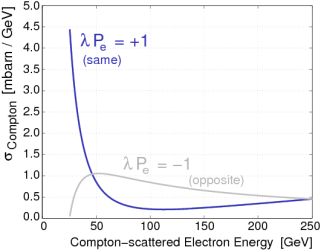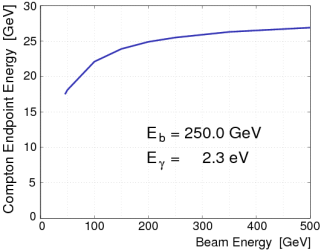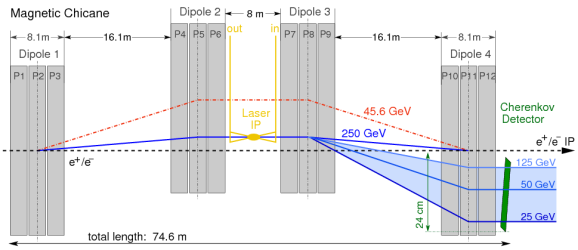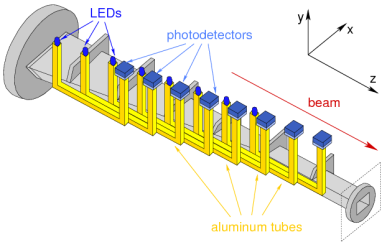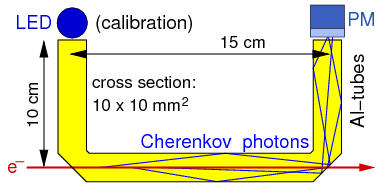Basics
Many physics processes depend on the longitudinal polarisation of the interacting particles. The use of polarised lepton beams at colliders can therefore offer new insights into the investigated processes. The planned International Linear Collider (ILC) will be using both polarised electron (P=80-90%) and positron beams (P=30-60%). In order to fully exploit the physics potential, the polarisation has to be measured with an as yet unequaled precision of ΔP/P ≈ 0.25%.
It is planned to use an overall of four Compton polarimeters at the ILC, measuring the polarisation of both beams in front and behind the e+e- interaction point (up- and downstream). A Compton polarimeter relies on the polarisation dependence of Compton scattering, i.e. the elastic scattering of polarised photons off polarised electrons. The energy distribution of the recoil electrons and photons depends on the product of the initial photon and electron polarisation. If the initial photons are generated by a laser with known polarisation the electron (beam) polarisation can be calculated from the measured recoil electron spectrum.
In our group we work on the design of the upstream Compton polarimeter for the ILC. It will consist of two components: a magnetic chicane where the Compton scattering takes place and a Cherenkov detector to detect the recoil electrons.
The polarisation will be determined by combining the measurements of two dedicated Compton polarimeters, located upstream and downstream of the e+e- interaction point, and data from the e+e- annihilations themselves. While the annihilation data will finally (after several weeks or even months) yield the absolute polarisation scale, the polarimeters provide fast measurements which allow to track variations over time and to detect possible correlations with the luminosity or the polarisation of the other beam. Therefore, each polarimeter has to reach a systematic accuracy of at least ΔP/P ≈ 0.25%.
Two polarimeters per beam are needed to measure the polarisation of the beams in collisions. Both polarimeters have been designed for operation at beam energies between 45 GeV and 500 GeV. A detailed description of the polarimeters, as well as of the overall concept to measure the polarisation and the beam energy can be found in [1].
Both polarimeters make use of the polarisation dependence of Compton scattering to ensure a non-destructive measurement of the longitudinal beam polarisation. Circularly polarised laser light is shot under a small angle onto the individual bunches causing typically in the order of 103 electrons or positrons per bunch to undergo Compton scattering. The energy spectrum of these scattered particles depends on the product of laser and beam polarisations, so that the measured rate asymmetry w.r.t. the laser helicity is directly proportional to the beam polarisation. Figure 1 (left) shows that the differential Compton cross section exhibits a large polarisation asymmetry near the Compton edge energy, which hardly depends on the chosen beam energy (Fig.1, right).
Since the scattering angle in the laboratory frame is less than 10 μrad, a magnetic chicane transforms the energy spectrum into a spatial distribution which is then measured by an array of Cherenkov detectors. Cherenkov radiation is independent of the electron energy (at least for relativistic electrons with β ≈ 1), hence the number of Cherenkov photons is directly proportional to the number of Compton electrons, which allows this type of detector to measure the energy spectrum of many electrons arriving simultaneously in one channel.
In our group we work on the design of the upstream Compton polarimeter for the ILC and on the design of suitable Cherenkov detectors for both polarimeters (up- & downstream of the e+e- IP). Each of the polarimeter consists of two components: a magnetic chicane where the laser light hits the particle bunches causing Compton scattering to take place, and an array of Cherenkov detectors to measure the spatial (energy) distribution of the scattered electrons (positrons).
Figure 2 shows a schematic view of the magnetic chicane for the upstream polarimeter. It consists of four dipole magnets and is approximately 75 m long. The first two magnets displace the electron (positron) beam vertically, before, in the center of the chicane at the Compton IP (between the second and third dipole) laser light hits the beam particles under a very small angle of less than 10 μrad. The laser power is chosen such that only a very small fraction of the beam electrons (≈ 1000) undergo Compton scattering. Therefore, the beam is not disrupted and polarisation measurements can be performed during ILC data taking.
The energy spectrum of the scattered electrons depends on the beam polarisation. In order this energy spectrum despite the very small scattering angle, the recoil electrons have to be separated from the majority of beam electrons that did not interact with the laser photons. This is where the magnetic chicane becomes important: the fields of the third and fourth dipole magnets guide the un-scattered beam electrons back toward their orignal trajectory (the main beam axis) and they continue their journey to the e+e- IP situated about 1.8 km further downstream. Meanwhile, the energy spectrum of the Compton scattered electrons is transformed into a spatial distribution, which is measured by an array of Cherenkov detectors.
Figure 3 (left) shows the conceptual design of a Cherenkov detector array as it is envisioned for the ILC polarimeters. The array will most likely consists of about 20 staggered "U-shaped" aluminum channels lining the tapered exit window of the ILC beam pipe. All channels will be filled with the Cherenkov gas C4F10, so that relativistic electrons traversing their U-base emit Cherenkov radiation which is reflected upward toward the photodetector mounted on top of the hind U-leg. One of these gas-filled channels is shown separately in Figure 3 (right). The light yield at the photocathode is directly proportional to the number of Compton electrons traversing the channel base. The combined information from all Cherenkov channels reflects the spatial distribution of the Compton scattered electrons which, in turn, is equivalent to the electrons' energy spectrum, so that the beam polarisation can be determined if the laser helicity is known.
There are several reasons why we want to use Cherenkov detectors for the polarisation measurement:
- In combination with the magnetic chicane, it allows to measure the energy spectrum of many electrons arriving simultaneously. With about 103 Compton interactions per electron bunch, a statistical precision of 1% is achieved for each of the about 3000 bunch position in a train after only 4 seconds. For the average polarisation of all bunch positions, this corresponds to a statistical error below 0.1% after 1 second.
- For relativistic electrons (β ≈ 1), Cherenkov radiation is independent of the electron energy. Thus, the number of Cherenkov photons will be directly proportional to the number of electrons per detector channel.
- Typical Cherenkov media like gases or quartz are sufficiently radiation hard to withstand the flux of 107 electrons passing through the detector per second.
However, improvements in various areas of the experimental setup are needed to develop a Cherenkov detector suitable for achieving the target precision of ΔP/P ≈ 0.25%. The requirements on the detector have been evaluated and according to these, a prototype detector has been designed, simulated and constructed.
[1] S. Boogert et al., Polarimeters and Energy Spectrometers for the ILC Beam Delivery System, JINST 4 (2009) P10015. [arXiv:0904.0122v2 physics.ins-det].


